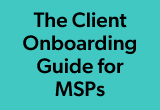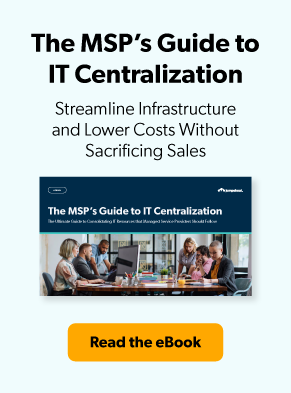Managed service providers (MSPs) are juggling a lot of responsibilities — overseeing identity and access management, managing compliance requirements, maintaining kiosks and printers, and dealing with help desk tickets. And that’s just for one client.
Multi-tenant management comes with increased complexity and the inherent security risk of accidental data sharing. At the same time, cyberattacks continue to get more sophisticated, making MSPs’ jobs even harder.
To overcome these challenges — let alone — scale, MSPs need a way to control access across their client base using a single platform.
In this post, we’ll explain how multi-tenant access control works, the benefits of role-based access control (RBAC), and share how JumpCloud’s multi-tenant portal and RBAC capabilities can help you scale.
What Is Multi-Tenant Access Control?
Multi-tenant access control enables identity and device management for distinct user groups (tenants) in a way that ensures data privacy while using the same underlying infrastructure and software. In an MSP context, each tenant is a different client organization. No data or activity is shared between tenants, enabling MSPs to safely manage their clients from one centralized platform without end-user disruption or security risk.
Typically, there are several components to multi-tenant access control solutions that help MSPs safeguard sensitive data, including authentication, data segregation, and, perhaps most importantly, role-based access control. These features help MSPs uphold their client’s privacy compliance requirements, such as GDPR or HIPAA, prevent data leakage, and guard against external and insider threats, increasing client trust and building their reputation.
The Need for Multi-Tenant Role-Based Access Control (RBAC)
Role-based access control, RBAC, is particularly important in a multi-tenant architecture. RBAC allows MSPs to define different roles across their client base, such as “administrator,” “user,” or “guest,” and assign specific permissions based on each tenant’s requirements.
Designating specific privileges helps MSPs establish and follow Zero Trust security best practices, ensuring each tenant’s users can only see and manipulate data they need to do their jobs — regardless of operating system or device. MSPs can also enforce end-to-end encryption, multi-factor authentication (MFA), single sign-on (SSO), and audit file movement and activity across all tenants in one interface.
But implementing role-based access control isn’t always a walk in the park. Some tools have complicated and highly manual setup processes. After that, each client has a different set of role-based requirements that must be properly configured, otherwise introducing gaps that cyberattackers or insiders can exploit.
JumpCloud’s Multi-Tenant Portal and RBAC Capabilities
JumpCloud’s Multi-Tenant Portal (MTP) is uniquely suited to help MSPs handle role-based access control without letting vulnerabilities slip through the cracks.
Overview of JumpCloud’s multi-tenant portal
At a high level, JumpCloud’s MTP authorizes MSPs to manage client identities and access controls across all resources — all through a single pane of glass. That includes web applications, Amazon Web Services (AWS), Azure, Google Workspace, and Microsoft 365.
On top of that, they can use JumpCloud’s MTP to force multi-factor authentication, offer SSO, and stabilize networks via RADIUS on every workstation, laptop, and server.
Features and benefits of JumpCloud’s RBAC capabilities
Within JumpCloud’s RBAC, MSPs can:
- Add and edit orgs in MTP
- Add and delete admins
- Manage multi-tenant billing
- Manage devices, groups, and users
- Manage application, directory, and RADIUS configurations
- Attend to account lockouts, and process password and MFA resets
- Manage authentication
- Use reporting features to view data and extract insights for their clients
JumpCloud makes it easy to reduce the chances of mistakes by assigning team members one of five roles within their client networks: Admin w/Billing (effectively a super user), Admin, Manager, Help Desk, and Read Only.
Case study of successful RBAC implementation
JumpCloud’s MTP has helped hundreds of customers take their security to the next level. Chase International is a fantastic example.
As a large luxury real estate firm, Chase International had 12 satellite offices, making remote work a tough transition for its small IT team. To make it as smooth as possible, IT leadership knew they needed a directory service that would keep them nimble while still achieving and maintaining NIST compliance.
JumpCloud was an ideal solution because of its ability to integrate with virtually any other software and operating system. With JumpCloud in place, the Chase International IT team could see who was logging in, where they were logged in from, and what they logged into at any time, anywhere. They could also push out full-disk encryption, manage hardware, software, and network updates, install JumpCloud’s Apple MDM, and implement SSO — all from their remote workstations.
Best Practices for Multi-Tenant Access Control
Implementing a multi-tenant portal is just the first step in taking control of an organization’s IT infrastructure. Let’s review several ways to reap the benefits of multi-tenant access control.
Tips for efficient management of permissions and privileges
Gathering client role requirements is a critical aspect of RBAC setup. One way to simplify access management is to assign them based on department function and org hierarchy. Keep in mind that you should always adhere to the least privilege principle and consider other methods of security enforcement as well, such as multi-factor authentication and encryption.
And don’t forget about onboarding. Users need to understand what their permissions authorize them to do and how to contact IT or the company’s MSP for temporary access they may need or questions they might have about their level of access.
Importance of regular assessment and review of access control policies
Companies are dynamic, so security policies need to be dynamic, too. Review business needs and security requirements with clients regularly to remove any unnecessary permissions and offboard old employees to reduce the potential for an insider attack.
Automate device and software updates with vulnerability patches and conduct other comprehensive security assessments, compliance audits, and penetration tests to catch security risks before they can be discovered and exploited.
Collaboration between IT and business stakeholders
Communication can make or break any project, including implementing multi-tenant access control. Align with clients or leadership on their security and compliance objectives, budgets, and needs.
Inform them of any major challenges you see on the horizon, test out new policies with end users, and work to design intuitive, quick processes that can be repeated over time. Request and be open to feedback and assist with change management where possible. All of these best practices will help you deliver a better overall experience, but they may also help you spot future expansion or upsell opportunities.
Streamline Multi-Tenant Management with RBAC and JumpCloud
Multi-tenant access control is vital to any managed service provider. Keeping track of all of your tenants, keeping up with new compliance and regulatory requirements, and keeping an eye on employees’ behavior minimizes the potential for insider threats and cyberattacks. But the tool you use to monitor and manage your clients matters.
JumpCloud’s directory platform has role-based access controls baked in, complete with granular access across Microsoft 365, Azure, Google Workspace, AWS, web applications, and more. With JumpCloud’s Multi-Tenant Portal (MTP), MSPs can impose security settings at scale, provide SSO to applications through SAML and cloud LDAP, and even manage networks through RADIUS.
What’s more, MTP gives MSPs the ability to assign their own roles and access levels within their managed organizations, allowing some team members to work on help desk tickets and others to assist with more in-depth tasks using admin privileges.
Start prioritizing access control in your multi-tenant environments with JumpCloud. Become an official JumpCloud MSP Partner and try it out for free today.





